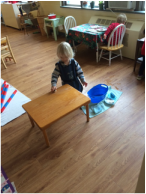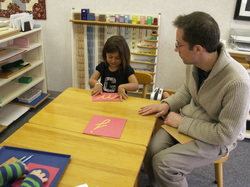The Primary Program
(3-6 years old)
"Education is a natural process carried out by the child and is not acquired by listening to words but by experiences in the environment."
Maria Montessori

The Primary Montessori classroom is designed to meet the developmental needs of children between the ages of 3 and 6 years old. Children of this age are motivated from within by a natural curiosity and a love of knowledge. In our carefully prepared Primary classrooms, children are guided by Montessori-trained teachers in their exploration of new concepts and ideas. The goal of the Primary program is to cultivate the child’s own natural desire to learn.
Each Primary classroom is staffed by one lead teacher and one assistant. Every student in these multi-age classrooms follows a unique education plan, tailored to meet his/her individual needs. The classroom is a vibrant social community, with younger children benefiting from the experience of the older students. The older students grow socially and intellectually while developing leadership skills and reinforcing what they have already mastered by sharing their knowledge.
The Primary Curriculum

The Primary Program promotes independence through expertly and specially designed environments with materials adhering to the developmental needs of children. There are five distinct areas in a Montessori Primary Community that allow the child to develop his/her character as well as his academic interests:
Practical Life
This is the first area of the classroom presented to and explored by children as they enter the Primary environment. These activities, including table washing, silver polishing, hand washing, plant watering, and food preparation, enable the child to care for himself and his environment. The young child is drawn to the ordered, purposeful presentations of these lessons and repeat the work frequently, leading to increased concentration.
Sensorial
Students are introduced to the Sensorial materials concurrently with the Practical Life exercises. This area, featuring materials designed to isolate concepts of size, color, shape, temperature, smell, sound, and touch, helps children begin to classify the world around them. These materials, which are scientifically and mathematically accurate, allow for countless amounts of exploration and manipulation by the students.
Language
The Primary classroom is rich in language, from stories told by the teacher to lessons in scientific vocabulary. Children are presented to the phonetic sounds of the alphabet through work with the sandpaper letters. As they begin to learn various phonetic sounds, the children are introduced to the concept of writing, a means of self-expression. Through Montessori language materials, children later begin to read, noticing that reading is a new way to explore their inquiries about their world.
Mathematics
The math area of the Primary classroom is full of “hands-on” materials designed to give the young child a sensory experience of mathematical concepts before they develop an understanding of abstract concepts. Children use the math materials to explore quantities, mathematical operations, squaring and cubing numbers, as well as fractions.
Culture
This area of exploration includes world geography, physical science, zoology, biology, botany, history, art, and music studies.
The three-period lesson is instrumental in fostering learning, whereby the first period consists of introducing new material. This is followed by the opportunity for the child to explore and discover the concepts previously presented, allowing for the concrete understanding and absorption of the material. The third period involves a clear demonstration of the knowledge acquired and mastered.
Once children are ready, generally around four or five years old, they move on the extended day whereby they remain in the classroom and do not nap. Children who are still napping have the option of being in the half-day program.
Practical Life
This is the first area of the classroom presented to and explored by children as they enter the Primary environment. These activities, including table washing, silver polishing, hand washing, plant watering, and food preparation, enable the child to care for himself and his environment. The young child is drawn to the ordered, purposeful presentations of these lessons and repeat the work frequently, leading to increased concentration.
Sensorial
Students are introduced to the Sensorial materials concurrently with the Practical Life exercises. This area, featuring materials designed to isolate concepts of size, color, shape, temperature, smell, sound, and touch, helps children begin to classify the world around them. These materials, which are scientifically and mathematically accurate, allow for countless amounts of exploration and manipulation by the students.
Language
The Primary classroom is rich in language, from stories told by the teacher to lessons in scientific vocabulary. Children are presented to the phonetic sounds of the alphabet through work with the sandpaper letters. As they begin to learn various phonetic sounds, the children are introduced to the concept of writing, a means of self-expression. Through Montessori language materials, children later begin to read, noticing that reading is a new way to explore their inquiries about their world.
Mathematics
The math area of the Primary classroom is full of “hands-on” materials designed to give the young child a sensory experience of mathematical concepts before they develop an understanding of abstract concepts. Children use the math materials to explore quantities, mathematical operations, squaring and cubing numbers, as well as fractions.
Culture
This area of exploration includes world geography, physical science, zoology, biology, botany, history, art, and music studies.
The three-period lesson is instrumental in fostering learning, whereby the first period consists of introducing new material. This is followed by the opportunity for the child to explore and discover the concepts previously presented, allowing for the concrete understanding and absorption of the material. The third period involves a clear demonstration of the knowledge acquired and mastered.
Once children are ready, generally around four or five years old, they move on the extended day whereby they remain in the classroom and do not nap. Children who are still napping have the option of being in the half-day program.

